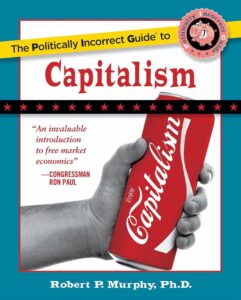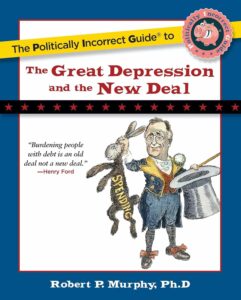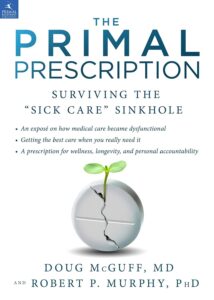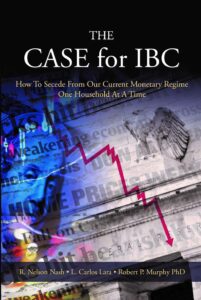My Heretical and Pathbreaking Work on Austrian Interest Theory
By popular demand, here are two things that are extremely geeky:
(A) My doctoral dissertation.
(B) A long paper I wrote for a recent Liberty Fund conference on Austrian business cycle theory.
I realize how obnoxious this sounds, but it’s just possible that I mapped out enough work to occupy the careers of three productive Austrians in the second paper. So some of you should glance over it to see if I’m nuts or onto something.
(Oh, be careful: I think footnote 4 in the 2nd paper is a little bit off. I noted a discrepancy between Sraffa’s discussion and a standard result in financial economics, but I think my suggested resolution is wrong. We discussed this issue on Free Advice back when I was writing the paper, and I haven’t fixed the footnote yet.)







I haven’t read the entire paper, and even if I had I am not qualified enough on interest rate theory to really comment authoritatively. Even if I was, we now the differences between the time preference theory of interest and the liquidity preference theory of interest. But, I don’t see how Sraffa’s criticism applies to intertemporal disequilibrium theory when we exchange Hayek’s theory of interest (which was not Misesian) for Mises’, where Mises’ theory of interest seems more like an aggregated theory of interest.
I do think that Sraffa brings up a valuable point that can be integrated into capital theory. How does the individual discount rates of different types of goods factor into how the structure of production is formed with changes in time preference? How does these discount rates reflect on the distribution of consumer preference in present consumption?
So, while it goes to show that capital theory is very incomplete, I don’t think it necessarily buries it.
I do think that Sraffa brings up a valuable point that can be integrated into capital theory. How does the individual discount rates of different types of goods factor into how the structure of production is formed with changes in time preference? How does these discount rates reflect on the distribution of consumer preference in present consumption?
The way I integrate Sraffa’s critique of Hayek regarding multiple “natural” interest rates, as it pertains to the ABCT, is by inferring that a given increase in bank reserves by the central bank will reduce interest rates on various loans across the board that would have otherwise been higher, thus reducing interest rates as such. It may decrease interest rates on 30 year mortgages more so than it decreases interest rates on revolving credit lines, or vice versa. But it does reduce interest rates as such.
I think I remember you writing an article about the possibility of there being a credit expansion-induced business cycle concentrated in consumer goods, and a credit expansion-induced business cycle concentrated in capital goods. Was that you? Kind of like Murphy’s sushi model, but instead of the economy being pulled equally in both directions, so to speak, where intermediate capital goods are used up without replacement, the economy gets pulled more so in one direction than the other. For example, a credit expansion induced consumer boom will redirect scarce resources away from the vital higher stage capital goods industry and make the given consumer boom unsustainable because the resources needed to sustain the boom are not available in the sustainable sense, because the demand for capital goods relative to consumer goods is not high enough to justify the given consumer boom.
Without credit expansion, then should there be a consumer boom on the basis of low interest rates for credit lines for example, and thus relatively less investment is made in capital goods, then the ate of profit and height of interest rates on loans will start to rise in the capital goods industry relative to the consumer goods industry. The coordination principle will, according to the ABCT, thus manifest itself and investors will start to realize that capital goods investment and lending money in the capital goods industry will start to become relatively more attractive, and that will balance the economy back out and stop the relative consumer boom. “Don’t forget that the more houses are demanded, the more need for nails and the higher the profitability for making nails!” kind of thing.
Credit expansion prevents profit and thus interest rates in a given stage or sector from changing relative to other needed stages in the production cycle. It is just like me printing off billions of dollars in my basement, then buying up as much food as I can, and then when investors start making relatively more investments in food retailing, they wonder why the supply of food is decreasing. It’s because the food consumption boom was financed external to the market’s balancing mechanism. It didn’t come from within the market such that the food consumption boom started with a reduction in spending or investment elsewhere.
I gave it a quick read and it certainly looks very interesting. For some reason, I don’t know why, I think that Austrian Macro, would immensely benefit from circuit theory as is used by Steve Keen. He uses a system of differential equations to model the endogenous money and he gets results that are awfully similar to the current depression: a debt overhang.
I stumbled across him due to this video (http://www.youtube.com/watch?v=1L6-loOZYLc& , it’s good fun) and read some further on his site, the lecture section and then in particular the financial economics section on the circuitist school.
Regarding this:
Robert P. Murphy, “Multiple Interest Rates and Austrian Business Cycle Theory.”
I have to say it: what a splendid paper!
Without any doubt and with genuine praise, I would say: this paper is best attempt to improve and build on the Austrian trade cycle theory I have seen in a long, long time.
Thanks. Of course, your praise will just make Austrians more suspicious of it…
For what it’s worth, I will say that I thought it was an incredibly awesome paper.
Not just the main content, but the small details too.
Highlights for me:
When you discussed the early 1980s and early 1990s where short term rates rose, but it was not followed by recession as what typically occurs, based on the speculation that since both long term and short term rates moved in tandem, it could be a result of actual savings changes. It was interesting because for me, I typically equate rising interest rates as the result of the Fed “letting” rates rise, as in a purposeful tightening. I used to look at those episodes with trepidation because the rising rates did not lead to recession. But your idea made sense. If you look at the episodes where rising short term rates did lead to recession, they showed a marked decrease in the spread between short and long term rates, signalling the likely possibility that the relative rise in short term rates was due to monetary policy, and not some general social change in savings behavior.
Oh, and thanks for enabling an agreement with Lord Keynes about something.
Final note: You said Rothbard was “confused” about term structure of interest rates, and about his adherence to ERE construction. That was a very puzzling thing to read, because you went out of your way to pull Rothbard’s name into that little snafu regarding liquidity preference theory of interest rates, as if the fact that Rothbard’s statements being consistent with yours (I think Wenzel showed that they are not) makes your arguments more correct. To then see you say Rothbard was confused about something kind of felt like a double standard.
Hey Bob, have you read Hulsmann’s recent work on the structure of production (he presented it at the ASC this year)?
Not sure which paper you mean, Beefcake. The only recent thing from him I read, was the paper he too wrote for that Liberty Fund conference. It had stuff like population growth in it. If that’s the one you mean, then yes I read it.
It’s this one:
guidohulsmann.com/pdf/Structure_Production_Reconsidered.pdf
Is there a link for this Liberty Fund conference?
No there’s no link; the Lib Fund conferences are closed door, cigar-smoking, libertarians taking over the world sessions.
Yeah that’s the paper (or some version of it). As with most of Guido’s stuff on this, I love his willingness and audacity to throw Mises under the bus, but I don’t like what Guido is suggesting as a replacement.
If the primary point that you took away from this paper is that it “had stuff like population growth in it,” then I’d say you’re not really justified in expressing judgment on how Hulsmann is revising Mises’ work.
Give me a break, Beefcake. I’m saying, Hulsmann was saying things like, “The standard views on savings and interest rates are wrong, because population could change or XYZ…” when nobody ever denied that those types of things had to be held constant for the original principle.
Maybe he said these things at the Liberty Fund conference, but it’s pretty clear you haven’t read this paper in any substantial form.
Well your deductive powers have failed you then. I did read the paper, and I’m saying he had a hard time making his point because he was challenging “the conventional Austrian account” where some of his observations weren’t challenges at all.
I do admit that I can’t recall right now if I agreed with his point about the pure rate of interest and roundaboutness.
I didn’t say you hadn’t read it, but that you hadn’t read it thoroughly. I.e. you failed to comprehend it.